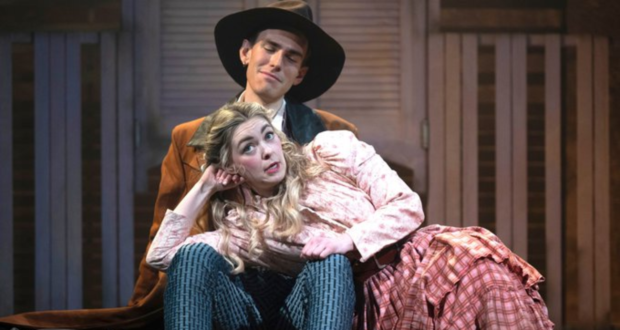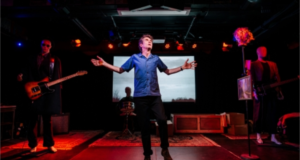Irreverent, joyous, effortlessly sung adaptation of Rossini's The Barber of Seville, set to spaghetti western.Summary
Rating
Good
On Wilton’s Music Hall’s stage, Charles Court Opera puts seven singers in western garb amid makeshift saloon swing doors and a piano player. They sing what feels like as an entirely new libretto in English to Rossini’s The Barber of Seville, and the audience is simply mad with delight.
The quality of singing in this production is astonishing. Both Figaro (Jonathan Eyers) and Lindoro/Count Almaviva (Joseph Doody) have pure and light, lyrical baritone and tenor voices respectively, with crystal clear enunciation and wonderful timbre. In addition, Figaro is a dashing figure, quite unlike most operatic representations of a rotund and jovial fellow, and gives us a sly, rake-thin and gangling maverick in a sweeping coat, Stetson hat and trim waistcoat.
All the singers both sing and act their parts with great gusto. Such is their skill that it all appears to come together effortlessly: one hardly notices the pauses for breath, a must for Rossini’s demanding pace and arias. Despite the fact that they are never still, are always miming or gesticulating and sometimes also dancing, no member of the cast ever gives away the deep breathing technique required of operatic voice projection. Compared to a motionless, statuesque Pavarotti-style singing, the Charles Court Opera cast find a way to connect the audience to the music and the words that is natural and almost casual.
Rosina’s part (Samantha Price) is also sung beautifully and the acting is most enjoyable. There is even room for an opera lover’s inside joke: while pretending to be given singing lessons by a maestro, who is none other than Lindoro in disguise, Rosina mimes the movements and the gestures typically associated with Bel Canto Italian technique teachers, who draw their hands into an arch-like motion, indicating that the sound of the voice should go round from the back of the throat to the back of the nose and almost come out of the forehead before being projected. Of course, they also hold their belly, indicating that the breathing needs to be supported from the diaphragm.
This fun little exchange is only one of many throughout the opera, brought to an atmospheric theatre that could easily have been a spaghetti western film set in its own right. This is an irreverent and entertaining production to make even the most dismissive of audiences fall in love with opera again.
Libretto translation and adaptation from the Italian by: David Eaton
Music by: Gioacchino Rossini
Produced by: Charles Court Theatre
The Barber of Seville plays at Wilton’s Music Hall until 23 March. More information and tickets can be found here.
 Everything Theatre Reviews, interviews and news for theatre lovers, London and beyond
Everything Theatre Reviews, interviews and news for theatre lovers, London and beyond



